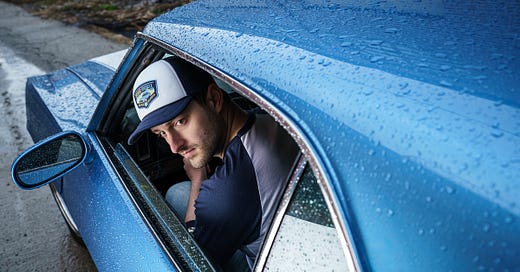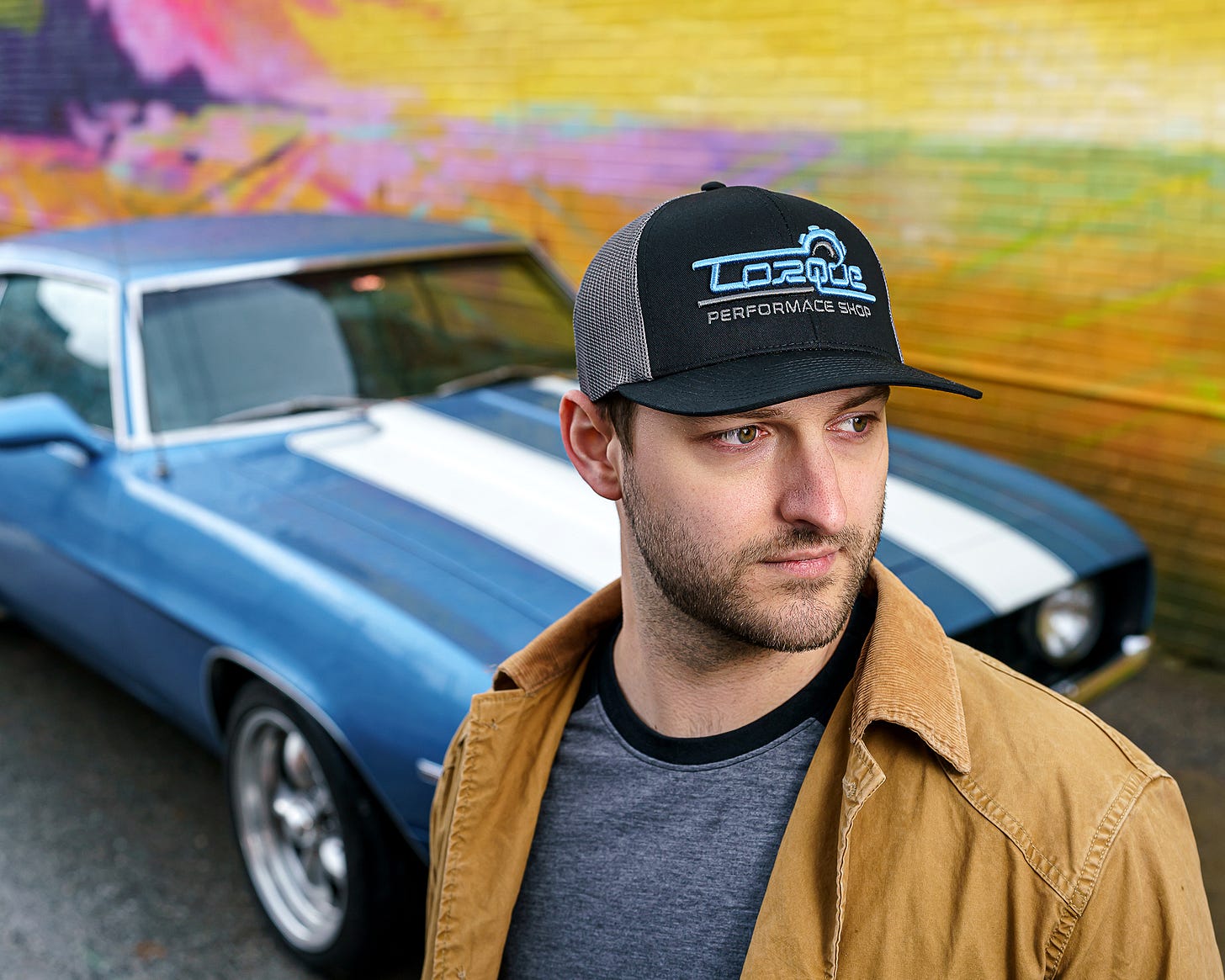This Is One of the Most Difficult Things About Photography
Viewers only see the finished product, not how it was made
As I sit writing this in the front seat of my car, it’s 6:41pm and I’ve just dropped off my daughter at ballet. I could go inside, but I’m sitting in my car because I’m fairly certain I’m momentarily going to close this computer, recline this seat and fall deeply asleep. I’m beat. Today was the last of a three-day outdoor photo shoot. Ten models, a handful of crew, multiple locations… And a 90-minute downpour.
With so many moving parts, the only practical option (without a monstrous budget, I mean) is to make a weather call 24 hours in advance of a production. If you cancel the day of, everybody still gets paid but you don’t get any work done. So to avoid that, if the forecast looks bad, we postpone in advance.
This week’s forecast wasn’t awful, though, so we were all a bit surprised when we noticed a sprinkling of raindrops as we broke for lunch. Fortuitous, I thought, that this rainshower would occur while we’re taking a break.
Not fortuitous, though, was the fact that it continued through lunch and 90 minutes more, all the way through the next shot on our list.
What’s the big deal? Well, for one thing we’d rented a 1969 Camaro for two shots, and reserved a fairly specific location. Neither relocating nor postponing were especially viable options.1
As we sat in our cars contemplating plans B through L, someone suggested we use one of my favorite light modifiers (the Photek Sunbuster) as a proper rain-stopping umbrella. We could cover the talent with the Sunbuster, and then use a regular umbrella to keep most of the water off of me. The car would have to sit out in the rain, however, getting completely drenched.
So we pulled the car into the alley, parked it just so, and then finagled our way around utility poles and general detritus to get the right position to at least make a frame of a guy in a hat with our expensive blue prop in the background.
In the process, even though we were umbrellad, everyone on the crew got soaked to the bone. Water was bathing the strobe, pouring from my hood onto the camera, soaking everything and everyone — except for the talent, of course. It’s good to be the talent.
In the end I made some photos that are by most metrics perfectly fine. But by other metrics — the ‘turn lemons into lemonade’ metric, the ‘work some freaking magic in a downpour’ metric, the ‘make it look like it’s not miserable out’ metric — we made absolutely amazing pictures. Because did you see what we’re dealing with?
No, you didn’t. Because you’re the viewer, and you just see the shot. How it was made doesn’t matter. In fact, there’s no way for you to know if I don’t tell you. And it’s rare that I get to tell you.
So when you see the photos you go, “Whatever. Meh.” And when I see the photos I go, “Omigosh can you believe this awesomeness!” Because I know it was all but impossible to do this, but we did it anyway.
It’s one of the trickiest situations in photography, I believe. We bend over backwards, make magic in the middle of a downpour, or spend three weeks perched in a jungle canopy to capture the perfect moment for our National Geographic cover. Or we spend a fortune in talent and locations and styling for our fashion shoot.
We made it, so when we look at it we see all the effort that we put into it. That can’t help but influence how we feel about it.
The problem is, it means we can’t judge our work accurately. We become fond of images we shouldn’t, because they just aren’t that special. But we can’t separate the challenges we overcame from the cold hard truth of the results alone.
But you know who can separate the “how” from the “what”? Everybody else who views the picture. They don’t know you climbed a roof and sat precariously for hours, or that you’d broken your wrist the day before, or that you got up in the middle of the night and hiked an hour in the dark to capture the perfect light. They don’t know anything at all. And they don’t care. The only thing they care about is the photo.
It is what it is, it’s not how you made it.2
It’s a bummer, really. It’s only fair that every photo be judged against how difficult it was to pull off, right? My rainy Camaro portrait is a perfect 10 once difficulty is factored in. But Avedon’s photographs of top tier models in world class fashions with the best stylists anywhere… Those are mere threes and fours, I say, because in that context, for one of the world’s best photographers, how hard could it be?
We should score such things like Olympic figure skating or gymnastics. There’s artistry and technicality, but also a difficulty multiplier. I want some credit for turning chicken shit into chicken salad. It’s a skill!
It very much is a skill, and it’s what my commercial photographer colleagues do on the daily. We’re kneecapped by slashed budgets or surprise changes, compromise after compromise, and yet we’re expected to persevere. For the most part, we do. Because, I think, that’s the job. It’s not nearly as much dreaming up fantastic images as it is figuring out how to implement a client’s specific vision. Or making a portrait match what another photographer halfway across the country did. Or achieving three times the work in one third of the time. The gig is often about making something sub-optimal look supreme.
Photography is so often about compromise. So when you can manage to pull off a challenging shot, with fewer compromises than anticipated…. Well, you’re probably making something great.
Sometimes this job is really challenging, and a wet butt is no fun, and crawling around on the pavement is no fun, and fighting the rain is no fun. But somehow it adds up to a job that’s incredibly fun, and frankly gratifying. Some people spent the day at a desk, calculating amortization schedules or filing TPS reports. I got to wander around the city playing four-dimensional chess with Mother Nature and my client’s shot list. How fun is that? It could be worse, wet butt aside.
Anybody can make a great photograph under perfect conditions and with an unlimited budget. But nobody ever seems to get that. So my badass colleagues and I, we take awful circumstances and make something halfway decent out of them — sometimes something even amazing. We work a little magic, take unpredictability out of the equation, and make sure, if nothing else, we get the shot. Frankly, I’m proud of us.
Now I’m going to recline the seat and doze off. To sleep, perchance to dream… of dry socks and challenging productions ahead.
We could always reconvene and do it again, but since we’re here already, why not give it a go?
There are mild exceptions. Knowing the context for an image can add all sorts of meaning and wonder. But it’s typically context that pertains to the contents of the frame, not the challenge of making of it.







On the upside, in the second pic - model in the car - the water droplets on the car add to the image.
Should I care if you made the image with the newest Fujifilm 100 pixel camera or an old Kodak instamatic? Ought not the image stand by its own merits? The high end camera can take lousy images, and the instamatic can take great images - it depends on whose hands the camera is held.
Effort is not enough to turn a lousy image into a great one.